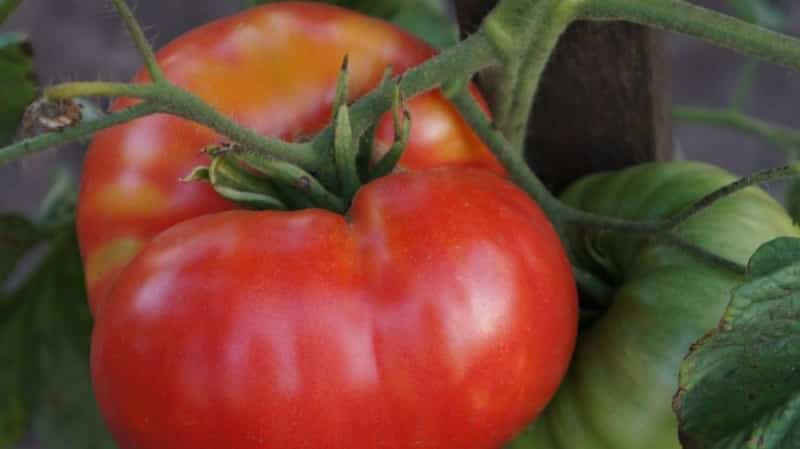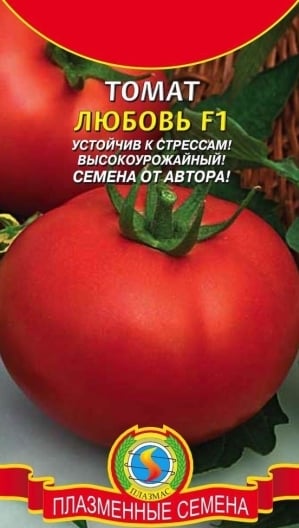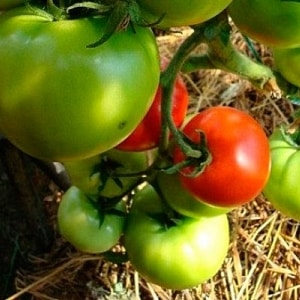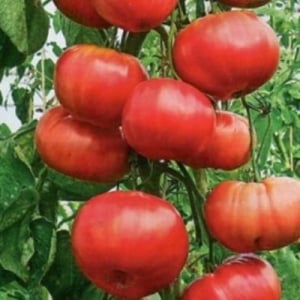New hybrid “Love”: planting scheme and care features for a good harvest
Tomatoes with the romantic name Love f1 are suitable for growing even for beginners. Summer residents speak positively about this hybrid due to its unpretentiousness and good yield. What are the characteristics of tomatoes and how to get a rich harvest of beautiful and juicy fruits with minimal care - read in our article.
Characteristics and description of the fruit
Hybrid Love F1 is determinant a plant whose growth is limited to the inflorescence. In open ground, the bushes reach 80-90 cm, and in greenhouse conditions the crop grows up to 130 cm.
Branching is moderate, there are few dark green leaves of medium size on the plants. Inflorescences of a simple type. The tomato forms up to five clusters, each with 5-6 ovaries. Pedicel with articulation.
The fruits grow approximately the same size, can be smooth or ribbed, round or flat-round in shape. Under favorable weather conditions, a “spout” appears at the top. An unripe tomato is light green in color, while a ripened one is red.
 The pulp is juicy, tender, sugary and melting. The density of the tomatoes is moderate; when cut, they do not spread and look very beautiful. The fruit has six seed nests. The taste is excellent. The fruits are used universally: they are used for preparing salads, processing into juice and pickling.
The pulp is juicy, tender, sugary and melting. The density of the tomatoes is moderate; when cut, they do not spread and look very beautiful. The fruit has six seed nests. The taste is excellent. The fruits are used universally: they are used for preparing salads, processing into juice and pickling.
Love f1 matures in a short time. From the moment of emergence of seedlings to the fruiting of the crop, 100-105 days pass. The weight of one tomato ranges from 200-230 g.The yield in greenhouse conditions is 15-20 kg per 1 sq. m. Tomatoes do not crack.
Plants have strong immunity, especially to tobacco mosaic. Tomato Lyubov f1 tolerates drought and temperature changes well.
Advantages and disadvantages
Vegetable growers value the Lyubov f1 tomato for the following advantages:
- precocity and simultaneous ripening;
- resistance to pests and diseases;
- high taste qualities;
- good transportability;
- versatility in use;
- crack resistance;
- high productivity;
- marketable condition;
- resistance to lack of moisture.
There are no shortcomings in the hybrid, except for the high demands on fertilizer and pinching. Love f1 has more positive qualities. Against their background, minor flaws are invisible, which is why many gardeners prefer these tomatoes.
How to grow
Summer residents often buy seedlings, but mostly they grow them themselves 1.5-2 months before planting them in open ground. It is better to plant when the weather is warm outside without returning frosts. Otherwise, the culture will die.
To obtain maximum yield, plants are fed with fertilizers. Although the hybrid is resistant to most infections, measures are still taken against possible diseases and pests.
Did you know? Hybrid vegetables are obtained by crossing two varieties with certain properties. This is done manually in sterile laboratories. Therefore, seeds collected from your own harvest do not retain the same qualities or do not grow at all.
Timing for sowing seeds for seedlings
By the time the seedlings are planted in the ground, they should be at least 55-60 days old.If you plan to plant tomatoes in a heated greenhouse, then the sowing time is February-March, depending on when you plan to get the first harvest. To plant tomatoes in open ground, seedlings are grown from March.
On a note. Love F1 after the first harvest gives an additional harvest.
The soil
Soil quality is an important factor for obtaining a good harvest. Tomatoes need loamy, loose soil with the addition of sand, silt and clay. Before use, it is tested for acidity. The acidity level (pH) for tomatoes should be from 6.2 to 6.8. If it does not meet the norm, the soil is fertilized.
To improve soil quality, add organic fertilizers:
- peat;
- compost;
- manure.
The richer the soil, the better the crop grows.
To get rid of putrefactive bacteria or pests, the soil is watered generously with boiling water. High temperature kills various microorganisms. For the same purpose, the soil is treated with a 1% solution of potassium permanganate.
Growing container
Various containers are used to grow seedlings:
- wooden or plastic boxes of different sizes;
- plastic or polypropylene cups;
- special containers;
- peat tablets or cups.
Any container of the required size that you have at home will do, including cut-off bottles or milk cartons. You can also purchase containers in the store. The best option is tablets or peat cups, as they contain a very nutritious soil mixture.
Another advantage of such products is replanting. When picking, simply move the tablet into a larger container. Over time, the peat walls dissolve into the soil.The root system is not damaged during transplantation, and the plant itself does not experience stress when conditions change.
Seed preparation
To obtain a high-quality and rich harvest, seed material is treated against possible diseases and pests. Good seeds are brightly colored and do not float when soaked in water. Beans that have been stored for more than a year will be yellow or pale gray in color. If this is what you have, you should soak them in a growth stimulator.
Before sowing, seeds are disinfected as follows:
- to destroy the larvae and eggs of pests, place the grains in hot water for 10-15 minutes;
- from fungi, mold and rot, the seeds are disinfected in a weak 1% solution of potassium permanganate for 20-30 minutes.
These procedures destroy fungi that may be on the seeds. For accelerated germination and uniform germination of tomatoes, the grains are soaked in a growth stimulator for 15-20 hours.
For this, drugs such as:
- "Energen";
- "Zircon";
- "Baikal EM-1".
Specialized stores sell many similar products. They are used strictly according to the instructions indicated on the packaging.
Did you know? Tomatoes are recognized as the most popular product in the world. The annual cultivation of this vegetable yields a harvest of more than 60 million tons. In second place are bananas, and in third are apples.
Sowing
The most convenient way to plant seeds is using peat tablets. They are placed in plastic containers and moistened. When they increase in volume, seeds are placed in them and the container is wrapped in film to create greenhouse conditions.
The container is ventilated once a day. Plants are transplanted when roots emerge from the cylinder.
To grow seedlings in boxes, the soil is pre-treated with a 1% solution of potassium permanganate.Seeds are sown at a distance of 2 cm between them and 3 cm between rows. Planting depth – 1 cm.
Seedling care
 When the seedlings have 2-3 true leaves, the sprouts are transplanted into separate containers. Plants are given space; they should not grow in crowded conditions. Leaf touching each other slows down the development of seedlings.
When the seedlings have 2-3 true leaves, the sprouts are transplanted into separate containers. Plants are given space; they should not grow in crowded conditions. Leaf touching each other slows down the development of seedlings.
It is provided with good direct light, but winter days are short, so artificial lighting is provided for tomatoes for 15 hours a day. To do this, use phytolamps or a system of LEDs. The lighting is set evenly, otherwise the plants will begin to deform.
The air temperature in the room is maintained at least 18°C. While growing seedlings, several feedings are carried out at intervals of 14 days. The first feeding is carried out in the phase of 2-3 true leaves.
Tomatoes are fed according to the following scheme:
- For the first and second times, fertilize with nitrogen, potassium and phosphorus in a dosage of 5/5/10 g per 5 liters of water.
- The third and fourth fertilizing is carried out with urea, potassium and superphosphate in a dosage of 10/15/20 g per 10 liters of water.
All fertilizers are applied to moist soil. Tomatoes are watered as needed, but at least once a week.
Did you know? There are more than 7,000 varieties of tomatoes in the world.
Hardening
Upon reaching the age of 40 days, the seedlings begin to harden. At a daytime temperature of 15°C, the plants are taken out into fresh air for 1.5-2 hours. Gradually, the time spent on the street is increased to 6-7 hours. This helps the seedlings to better tolerate transplantation into the ground and makes them resistant to weather factors and diseases.
Planting seedlings in a permanent place
At the age of 55 days, the seedlings will have 8-10 true leaves. At this time, the plants are planted in a permanent place of growth.The seedlings are transplanted into open ground after the last spring frosts. When it gets cold, the root system is covered mulch.
When planting, about 60 cm is left between tomato bushes. This distance is sufficient for the growth and development of the crop. Plant plants in rows - this will make it convenient to care for tomatoes and harvest. Rows of tomatoes are arranged in a checkerboard pattern or parallel to each other.
On a note. When planting in a permanent place, the seedlings are deepened into the ground up to the first leaves. This stimulates the growth of additional roots and enhances the development of bushes.
Caring for tomatoes in open ground
Each mature bush requires approximately 12 liters of water per week. They water early in the morning to provide the plants with water throughout the hot day, but some vegetable growers water the crop in the evening, since it mainly grows at night and the moisture at this time goes to its intended purpose, and does not evaporate under the hot sun.
For the root system to be strong, water must penetrate deep into the soil. Mulch helps retain moisture during the day and protects leaves from splashes during watering.
On a note. Some gardeners place flat stones next to the plants. When watered, they absorb moisture and gradually humidify the air during a hot day.
Top dressing
Seedlings planted in the ground are fed after 10 days. During this time it should take root well. Fertilize with organic matter in the root zone. To do this, 0.5 kg of mullein is stirred in 10 liters of water. For each plant, use 0.5 liters of solution .
.
Next feeding carried out with mineral fertilizers 10 days after the first. To do this, use superphosphate or potassium sulfate (1 tablespoon of the drug per 10 liters of water). Each bush is fertilized with 1 liter of solution.In the future, feeding is alternated.
Soil care
On the second day after watering, the soil is loosened to a depth of 8 cm and weeds are removed at the same time. Tomatoes also spud. This improves the root system, which has a positive effect on the harvest.
During the entire growing season, the bushes are earthed up twice: 21 days after planting in a permanent place and during active flowering.
Prevention of diseases and pests
Love f1 tomatoes are susceptible to diseases such as:
- late blight;
- apical and root rot.
For preventive purposes against fungi, plants are treated with a 1% solution of potassium permanganate or the preparations “Quadris” and “Acrobat”.
Important! Affected parts of plants must be removed and burned.
In addition to diseases, plants can be attacked by pests: slugs, cutworms, aphids. Insects are destroyed with garlic infusion (200 g of grated garlic or onion per 10 liters of water).
Chemicals are also used in pest control:
- "Karate";
- "Meta";
- "Decis";
- "Storm".
To get rid of slugs, red pepper, crushed eggshells, and pine needle mulch are sprinkled around the bushes.
Reviews from gardeners
Vegetable growers respond mostly positively to the Lyubov f1 tomato.
Anastasia, Izhevsk: “There are always a lot of tomatoes growing in my beds. One of them is the early hybrid Lyubov f1. I like these tomatoes for their ease of care and good yield. The vegetables grow very beautiful, as in the photo of the package with seeds. The tomatoes taste very pleasant. I’m happy with the tomatoes and will continue to grow them.”
Svetlana, Mtsensk: “My neighbor always boasted about her Lyubov variety tomatoes. I decided to try growing these tomatoes. The plant turned out to be very prolific indeed.I care for tomatoes according to the standard scheme, as with all determinate varieties.”
Vladimir, Rostov-on-Don: “Last year I tried to grow Lyubov f1. The characteristics and description of the tomato variety indicated on the package exactly match the one that grew. Fruits ripened near the roots are sweeter and juicier than those at the top. Last year I planted it at the wrong time and picked brown tomatoes, which ripened on their own, but weren’t as tasty.”
Conclusion
Among summer residents, the Lyubov f1 tomato has proven itself well. Even a novice vegetable grower can grow a hybrid: the crop does not require special attention and is resistant to lack of moisture and most diseases. Valued for the beautiful appearance of the fruit, sugary pulp and versatility in use: tomatoes are suitable for both fresh consumption and processing.